For the longest time, science fiction and fantasy have been considered genres in which the political and social issues of the day could be discussed behind the allegory of alien worlds, superheroes, and other realities. If, for example, two guys wanted to get together and write a comic book character that would epitomize the experience of the immigrant in an evolving America, they could slap him into a rocket leaving the exploding planet of Krypton and call him Superman. It’s no surprise then that in the evolving social consciousness that is our world today, one of the hottest issues in sci-fi and fantasy would be the inclusion of LGBT relationships among characters and the hot button issue of gay marriage.
With the announcement of President Obama’s support of gay marriage and the huge push for LGBT relationship support across the country, the last few doors of resistance seem to be breaking down to usher in an era of inclusion for gay characters. For the world of fantasy, gay characters are getting equal attention and story time at the hands of some of the best creators out there. We’ll look at the evolution of these representations across television, comics, and YA literature to see where LGBT characters have been and where our favorite fandoms are going.
Television: Going Boldly Where Star Trek Wouldn’t Go For A While
For years, larger fandoms were seemingly bereft of outwardly open gay characters. Sure, there were the serious couple overtones between Gabrielle and Xena but they were never truly acknowledged to anyone’s satisfaction. Gene Roddenberry’s Star Trek was one of the biggest offenders, with the Federation crews representing no open single-sex relationships unless it was used in a single episode for plot twist or comedic purposes. This was addressed with a single same-sex kiss in the late 90’s by the gender-switching Jadzia Dax in Star Trek: Deep Space Nine‘s episode “Rejoined” but that was about it. For an inclusive, “everyone is welcome” place like the Federation, LGBT people seemed curiously absent.
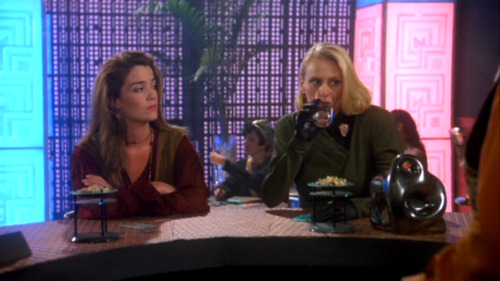
While this was going on, however, another science fiction show was making strides forward that Star Trek wouldn’t have even considered. J. Michael Straczynski’s space epic Babylon 5 not only had a lesbian relationship between two female characters, but one was the second in command of the space station. The relationship between Commander Susan Ivanova and telepath Talia Winters remained largely implied, however it provided serious emotional ground for Ivanova’s character that carried with her for seasons. The tradition of space shows embracing bisexual characters continued into Joss Whedon’s Firefly, with the Companion Inara Serra being comfortable with either male or female clientele. Yet it wasn’t until 2009’s Stargate Universe that an openly gay main character was portrayed in Camilla Wray, played by Ming Na.
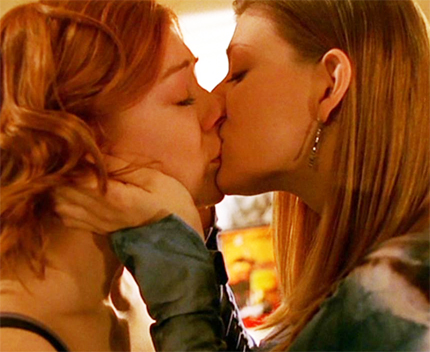
More examples of LGBT couples became apparent in the supernatural fantasy shows beginning with Buffy the Vampire Slayer in the late 90’s. Few can question the impact felt when Scooby gang member turned mega-witch Willow came out and began dating her fellow Wiccan Tara. Whedon continued that tradition later with his wannabe supervillain turned ally Andrew and in his spin-off Angel, where hints were dropped about possible previous liasons between Angel and Spike.
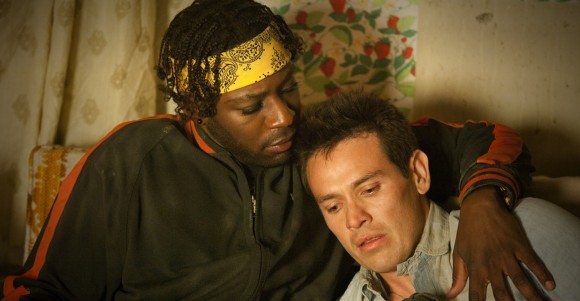
When True Blood debuted on HBO, there was no question that ghost-seeing Lafayette was a strong gay character for the urban fantasy TV set. What makes Lafayette such an interesting character is his complete evolution from a minor throw-away in the Sookie Stackhouse novels to a complex and powerful character in the television series. His relationship with brujo-nurse Jesus is a heart-warming staple of last season, juxtaposing the slightly twisted yet heartfelt relationship between vampire villain Russell Edgington and his lover.
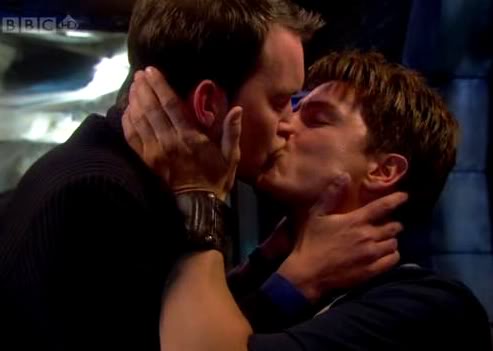
The time, it seemed, for gay characters to remain innuendo seemed over and nobody embodied that quite fact quite as much as Doctor Who heartthrob, the time-traveling omni-sexual Captain Jack Harkness. When Jack got his spinoff in Torchwood, one of the key parts of the series was Jack’s playful sexual antics. Yet it was his real relationship with Ianto Jones that gave the series and both the characters some unexpected depth. There was no “is he or isn’t he?” question with Jack Harkness any longer, no more of the off-screen moments only hinted at from previous scifi shows.
Similiarly, HBO put aside any questions of “is he or isn’t he?” with the relationship of Renly Baratheon and Sir Loras Tyrell in their second season of Game of Thrones. Where George R. R. Martin only hinted at Renly and Loras’s relationship in the novels, the HBO series made it abundantly clear that the two were lovers in a fantasy world that made their relationship difficult. One episode of the Renly/Loras relationship or any Lafayette/Jesus moments is enough to tell fans that the time for innuendo and off-screen romance is long over in science fiction and fantasy television.
Comics: Out of the Costume Closet
Gay characters in comic books have arguably had it harder than television. In an industry written for predominantly straight male readership, getting LGBT characters included in a way that wasn’t just girl-on-girl fan service seemed a foregone conclusion for years. Yet small rays of light did peak out and begin the way forward amid rampant controversy. The long-running comic Hellblazer features John Constantine, the morally grey magician who has been represented as bisexual since his comics’ inception in 1988.
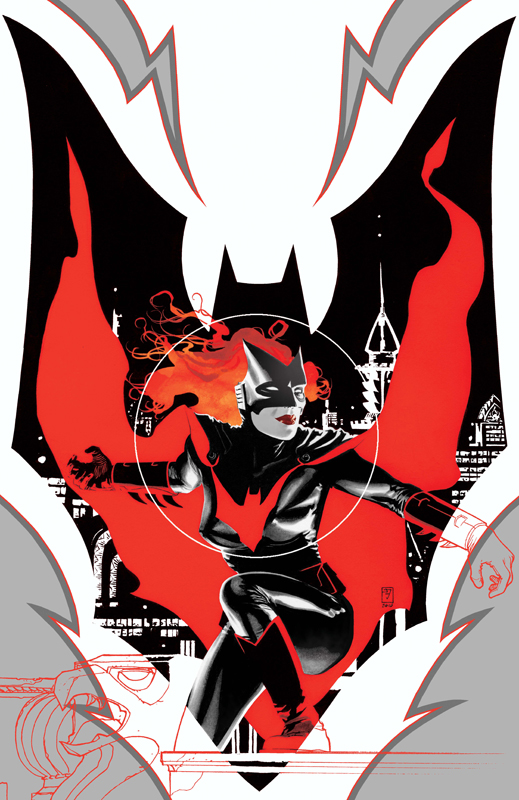
Other characters were indicated to be gay but the story was kept in the background, out of the way. It wasn’t until recently that comics have truly begun to come out of the costume closet and give gay characters their due. Three of the most recent examples are the rewritten Batwoman, the Young Avengers couple of Hulkling and Wiccan, and Alpha Flight‘s Northstar.
DC’s Cassandra Kane aka Batwoman was recently reestablished in comics as a powerful Jewish lesbian icon, with a tumultuous relationship with long-time Gotham police officer turned vigilante Renee Montoya (aka The Question). Yet while there have been very few DC Comics characters with such a strong LGBT presence in the past, DC Comics has recently announced that one of its major characters will be rewritten with a different sexual orientation for their debut in the rebooted New 52 world. Who that will be, we’re still waiting to see, but perhaps it signals a recognition by DC to bring about more gay representation.
Then again, their response could be in the face of a major move by Marvel Comics lately to highlight their predominant gay characters. The first move was to give young super heroes Wiccan and Hulkling their first on panel kiss in the mini-series Children’s Crusade after the characters had been in a long-term relationship for quite some time.
The second major move from Marvel, however, was a bit more impressive when they announced that Canadian Alpha Flight member turned X-Man Northstar would finally marry his long-term partner Kyle in Astonishing X-Men #50. Northstar was the first openly gay character announced in comics back in 1992 amid a firestorm of controversy that nearly buried the character for years. Yet it wasn’t until the recent legalization of gay marriage in New York that allowed Marvel to give Northstar and Kyle the first gay marriage in the comics two decades after the character came out to the readership. Whether this will signal a trend towards more diversity in comics, we can only hope.
YA Fiction: The Dumbledore Dilemma

If any medium for fantasy and scifi LGBT characters has had it harder than comics, it might be YA fiction. While YA readership has exploded over the last few years with sensations like Harry Potter, Twilight and Hunger Games, there has remained a serious absence of gay characters. J.K. Rowling did announce after the end of the Harry Potter series that Albus Dumbledore was always meant to be gay, yet that qualifier offered little to fans who might not have seen the Hogwarts Headmaster that way unless told otherwise. The trend seems to have become that should any character be written as gay in a YA novel, they must be a background character or so deeply in the closet that no one would even guess at their orientation. In a field that is aimed at young readership, one can understand and still be saddened that this is the state of scifi/fantasy YA today.
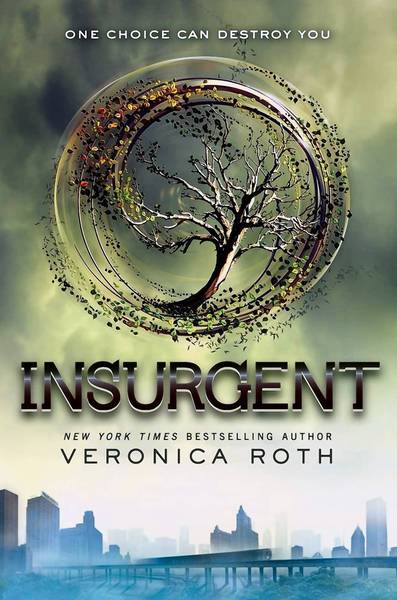 Yet little rays of light have emerged. Novels like Ash by Malinda Lo exist as does Vintage: A Ghost Story by Steven Berman from 2007. The recent release by Veronica Roth of Insurgent, her follow up to her smash novel Divergent, includes the mention of a little love triangle between side characters that includes a female character having a crush on another. And in Pandemonium, the sequel to the powerful Delirium, Lauren Oliver casually includes a gay couple among those living outside of the straight-laced controlled society of her novel. If not for these representations, however, the field seems strangely bereft of any LGBT inclusion. Given time, one can only hope that it will evolve as television and comics have.
Yet little rays of light have emerged. Novels like Ash by Malinda Lo exist as does Vintage: A Ghost Story by Steven Berman from 2007. The recent release by Veronica Roth of Insurgent, her follow up to her smash novel Divergent, includes the mention of a little love triangle between side characters that includes a female character having a crush on another. And in Pandemonium, the sequel to the powerful Delirium, Lauren Oliver casually includes a gay couple among those living outside of the straight-laced controlled society of her novel. If not for these representations, however, the field seems strangely bereft of any LGBT inclusion. Given time, one can only hope that it will evolve as television and comics have.
The evolution is still ongoing for fandoms and their mediums. Video game companies like Bioware face controversy when they include same-sex options for their characters. There was full-blown internet riot when Star Wars: The Old Republic MMO announced gay couples would be possible within the game. Yet it would seem that fantasy and science fiction audiences provide a more welcoming and accepting readership for LGBT characters, embracing change and difference with an open mind that hampers other genres. With that in mind, we can only look towards moves like Northstar’s wedding as a signal that gay characters have an open place among scifi and fantasy that could not have existed years ago.
Shoshana Kessock is a comics fan, photographer, game developer, LARPer and all around geek girl. She’s the creator of Phoenix Outlaw Productions and ReImaginedReality.com










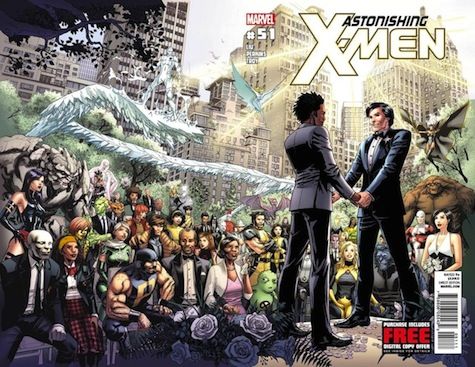
What about Alec and Magnus Bane in Cassandra Clare’s hugely popular Mortal Instruments series, or Jamie and Seb in Sarah Rees Brennan’s Demon’s Lexicon series? Justine Larbalestier’s How to Ditch Your Fairy has a questioning character (who, awesomely, has a “fairy” that means all the boys are attracted to her, but who doesn’t think she actually likes boys anyway). And those are just the ones that I thought of off the top of my head. It’s surprising to me that you couldn’t come up with more – YA, like everything else, is nowhere near where it should be as regards LGBT characters, but it’s better than most.
I agree with @BridgetSmith. My first thought when I got to the YA section was “There going to talk about Magnus and Alec.” Or Damien and Jack in the House of Night series. That’s two I can think of off the top of my head that have openly LGBT characters in relationships. Out of all of these mediums, I would say YA is the one most likely to include a LGBT character. It’s been a long time since I read a YA book that didn’t have one.
How is Northstar’s wedding the “first gay superhero wedding in the comics?” What about Apollo and Midnighter?
I’d also like to mention Vanyel Ashkevron from Mercedes Lackey’s Last Herald Mage (1989) series. Great gay character with a whole trilogy from the late 80’s to 90’s.
Ditto on Vanyel.
Tho, I will say that his story might not fit with the theme of this story. It is more angsty and depressing than the stories listed (perfect for a gay teen). I don’t want to be spoilery, but it’s some very serious and brutal stuff.
How about Uncle Sam Adama on the BSG prequel Caprica?
Articles like this are always labelled “LGBT,” but there’s never any “T” to discuss.
Thank you for writing this essay (and for mentioning my novel).
I think YA has offered in the last decade some terrific LGBT characters in a variety of spec fic books. Certainly there have been more and more titles with secondary characters–as opposed to leads–who are out and proud, like Magnus and Alec from Clare’s series.
Vanyel was so angst-ridden and became a pinata to me–I would never recommend that series to a teen.
As far as YA lit goes, there’s also Ashton Adams (the main character’s brother) in Lev AC Rosen’s All Men of Genius.
This should be called the Evolution of LGBT characters in *American* comics and lit. But really not in fandoms, or in foreign comics/lit. In fandom, people have been writing LGBT characters since they’ve been writing slash, not only in English but around the globe in every language.
And in Japan LGBT characters have been written in mainstream works as the focus of such since the 60s. Look up Moto Hagio and the 49ers. Their works about LGBT characters are consider literate classics any way you look at manga, and their tradition has been carried on through to works like the tour de force Revolutionary Girl Utena and gentle stories like Wandering Son.
Other characters: Alec and Seregil from the Nightrunner series by Lynn Flewelling. Tobin from her other trilogy is a girl who was raised as a boy. The Fool in Robin Hobb’d work is ambiguous for several books.
And I don’t normally plug my own work, but my debut YA Fantasy Pantomime has several characters on the QUILTBAG Specturm. Out from Strange Chemistry next year.
I believe Ragman is also gay.
To ComicsRiot,
If you are looking for the ‘T’ in books, look to Iaim M Banks. In his Culture Books he has characters that chnge their sex at will nd experience both sides of sexuality. It is considered closed minded if you didn’t.
It is not central to the stories, just given as fact. Try ‘The Player of Games’ as a start.
“Yet it wasn’t until the recent legalization of gay marriage in New York
that allowed Marvel to give Northstar and Kyle the first gay marriage
in the comics two decades after the character came out to the
readership.”
Northstar is Canadian, and isn’t Kyle also Canadian? Canada has had same sex marriage since 2005.
I’d also like to mention Shatterstar and Rictor from X-Factor as a pairing as well in the comic industry, their kiss (in issue #45) being toted as ‘the first “male/male romantic kiss ever to appear on-panel in a Marvel comic.”‘ I’m only quoting, here, but I have read Marvel for a while and I’m fairly certain I can agree with the statement. That, and I did check dates. Their kiss happened in 2009, Children’s Crusade started in 2010 and Northstar’s wedding is coming up. I can imagine there would’ve been more of a hullaballoo had he done any kissing when they first brought up his sexuality.
As for other teen books that address same-sex relationships, there’s also Hero by Perry Moore. Not only does the main character have to cope with developing superpowers when his father holds something of a grudge against heroes, he’s also coming to terms with his sexuality. The issue I have with the book, though, is that while the main character is supposed to be around 19 years old, he never quite feels that way (or, at least, I tended to forget how young he was.) There are some pretty memorable scenes (particularly when Thom has to out himself in front of a live audience) though some of the book leans a little on the cliche side. It’s a good read. Can’t say it’s fantastically ground-breaking, but it’s good.
(And okay, my posting captcha is outedcpo the. That’s just too funny.)
In mainstream, genre, but non-superhero comics, Neil Gaiman’s Sandman is full of queer characters – lesbian, bisexual, gay, trans. The second Death miniseries has a lesbian couple as the main characters.
Two indie examples that are comics, though not necessarily genre comics: Strangers in Paradise centers on the long, complexly romantic relationship between two women. Hopeless Savages is a comic centered around a family, one of the children is gay and his relationship is treated equally with other relationships in the story.
In the space between comics and comic strip, though not genre, again, I think Alison Bechdel’s long running strip Dykes to Watch Out For, and her memoir “Fun Home” both deserve mention here – and Fun Home is included in a number of YA collections I know of in the library world, including the one in my hometown. Bechdel’s series has included several trans characters, along with queer people of color.
In YA genre, Holly Black’s name should come up along with Cassandra Clare’s – they both have very strong sales and work deliberately to include LGBTQ characters, including characters in all three of Black’s Modern Faerie books. Ellen Kushner’s The Privilege of the Sword was published as adult but was widely picked up, at least in the library world, as an addition to YA booklists and collections – it features lesbian, gay, bisexual, and questioning characters in key roles throughout the story.
Cassandra Clare actually handles her LGBT characters very poorly. There’s a good analysis at this blog: http://www.fangsforthefantasy.com/2011/08/cassandra-clare-proves-that-all.html
I would suggest checking this list out and reading some of these books before making judgements on the presence and diversity of LGBTQ characters in YA literature.
http://www.alexsanchez.com/gay_teen_books.htm